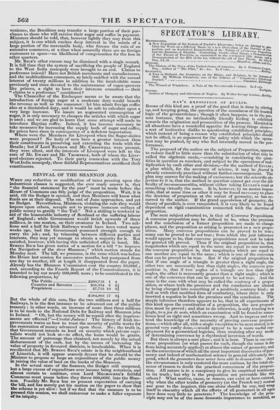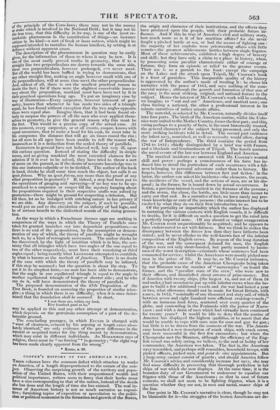DAY'S EXPOSITION or EUCLID.
Boom of this kind are a proof of the good that is done by stirring up, and keeping going, the question of the soundness of the boasted logic of the geometricians ; though it often happens, as in the pre- sent instance, that no intrinsically friendly feeling is exhibited towards the origination and prosecution of the process. Mankind in all situations have a wonderful appetite for leaving things alone--a sort of instinctive dislike to questioning established principles; which instead of being a reason why established principles should not be sifted, is an argument for the safety with which the opera- tion may be pushed, by any who feel internally moved to the per- formance.
The proposal of the author on the subject of Proportion, appears to reduce itself to little more than the substitution of what may be called the algebraic mode,—consisting in considering the quan-
tities in question as numbers, and subject to the operations of mul- tiplication by each other and division,—for the method of EUCLID; a plan which, for the accuracy of science, it may be feared is already extensively practised without further encouragement. The plan may answer for the making of excisemen; but the scientific ob- jection to it is, that the method in question cannot get over the dif- ficulty of incommensurables, without either taking Eucian's road or something virtually the same. It is, however, by no means impos- sible, that at some time or other it may be found necessary to place the doctrine of proportion at the outset of geometry, as has oc- curred to the author. If the grand opprobrium of geometry, the theory of parallels, is ever vanquished, it is very likely to be found dependent on rigid examinations connected with the doctrine of proportion. The next subject adverted to, is that of Converse Propositions. A converse proposition may be defined to be, when the premises and the conclusion of a former proposition are made to change places, and the proposition so arising is presented as a new propo- sition. Many converse propositions can be proved to be true; many can be proved to be not true ; from which the just inference would appear to be, that converse propositions must not be taken for granted till proved. Thus if the original proposition is, that magnitudes which are equal to the same arc equal to one another, the converse proposition is, that magnitudes which are equal to one another are equal to the same ; which is one of the converses that can be proved to be true. But if the original proposition is, that if one angle of a triangle is greater than a right angle, the other two are necessarily less than right angles, the converse pro- position is, that if' two angles of a triangle arc less than right angles, the other is necessarily greater than a right angle ; which is one of the converses that can be proved to be not true. And the same is the case with what may be called the contrary of a propo- sition, or where both the premises and the conclusion are altered by being changed into something of a positively contrary kind; as well as with that modified form of contrariety, where there is only inserted a negation in both the premises and the conclusion. The simple inference therefore appears to be, that in all experiments of this kind upon the constitution of a proposition, the new proposi- tion must be proved; and that to do otherwise, is only trusting to a jingle, to a feu de mots, which on examination will be found to some- times lead us right and sometimes wrong. And to impress and ex- tend the knowledge of the necessity of proving converse proposi- tions,—which after all, with a single exception to be next stated, is in general very easily done,—would appear to be a more useful em- ployment for a geometrical logician, than straining after any mode of determining converses by a rhythmical inversion of words. But there is always a sore place ; and it is here. There is one is proposition (or what passes for such, though the name s far from being accurately applied) at almost the outset of geometry, and on the correctness of which all the most important discoveries of geo- metry and indeed of mathematical science in general ultimately de- pend, which the geometers have never been able to demonstrate. And the circumstance is only rendered the more curious, by the total ab- sence of reason to doubt the practical correctness of the proposi- tion. All nature is in a conspiracy to give its empirical testimony to its truth ; but why is the proposition not proveable like the others? What motive, cause, or reason, can exist or have existed, why when the other truths of geometry (as the French say) =Went aux yeux to the inquirer, this one alone should be coy, and wrap itself in obscurity which all the efforts of all geometers in all ages have done very little to penetrate? The knowledge of .die prin- ciple may not be of the same domestic importance to mankind, as of the principle of the Corn-laws ; there may not be the money at stake which is involved in the National Debt ; but it may not be the less true, that this difficulty in its way, is one of the most re- markable phaenomena in the constitution of things—an instance unique in its kind—a sort of freak or luau mime, which might be supposed intended to tantalize the human intellect, by setting it at defiance without apparent cause. The description of the phienomenon in question may be easily given, for the information of those to whom it may be new. It is one of the most easily proved truths in geometry, that if to a straight line two perpendiculars are drawn towards the same side, these two perpendiculars, however prolonged, can never meet. But all the world has been baffled in trying to demonstrate, that any other straight line, making an angle however small with one of the perpendiculars, will at some time meet the other perpendicular. And, oddest of all, there is not the smallest practical reason to doubt the fact ; for if there were the slightest conceivable inaccu- racy about the proposition, mankind must have been met by it in their practical operations long ago. To put an imaginary case by way of illustration—Every carpenter, however innocent of geo- metry, knows that whenever he has made two sides of a triangle equal, he has found without exception that the two angles opposite them were equal also. Imagine then, that it had been found ut- terly to surpass the powers of all the men who ever applied them- selves to geometry, to give the general reason why this must be the fact. This would be a precise copy of the actual case. At this moment, every carpenter, or at all events, cooper, knows with equal assurance, that to make a head for his cask, he must take in his compasses the distance that will go six times round the rim ; but all men in all ages have been unable to tell the reason why, inasmuch as it is a deduction from the sealed theory of parallels. Geometers in general have not behaved well, but very ill, upon this curious question. Instead of stating the difficulty in simple terms, and so giving mankind the most extended chances for its solution if it is ever to be solved, they have tried to throw a sort of scorn on the pursuit, as if the desire of accurate knowledge was in this one instance culpable or to be derided. The author of the book in hand, thinks lie shall some time reach the object, but calls it an ignis fatuus. Why an ignis fataus, any more than the proof of any other proposition in geometry? If, indeed, a stop had been put to the operations of gauging and surveying—if no boy was to be ap- prenticed to a carpenter or cooper till the mystery hanging about the propositions required in their respective crafts was solved by geometers—there might be ground for suspecting a delusion. But till then, let us be indulged with catching nature in her privacy if we are able. Any discovery on the subject, if such be possible, would put an end to the circulation of an infinity of bad logic, and be of serious benefit to the dialectical morals of the rising genera- tion.
As the ways in which a Frenchman dresses eggs are nothing in comparison of the ways in which the Theory of Parallels once taken for granted branches out into dependent propositions,—so there is no end of the propositions, by the assumption or demon- stration of any of which, the theory of parallels might be wrought back to, by a kind of retrograde movement. The author thinks he has discovered, by the light of intuition which is in him, the cer- tainty that all triangles which have two angles of the one equal to two of the other respectively, must have their remaining or third angles equal ; being exactly what Luc ENDRE attempted to establish, by what is known as the method of function. There is no doubt of the ease with which the theory of parallels may be inferred, if this step be assumed ; but the question is about the step. To put it in its simplest form,—no man has been able to demonstrate, that the angle in one equilateral triangle is equal to the angle in another equilateral triangle of longer or shorter side ; and he who can do it, will have demonstrated the theory of parallels. The proposed demonstration of the 47th Proposition of the First Book, is founded on assuming the properties of similar trian- gles; a thing in which there is no difficulty, when it is once deter- mined that the foundation shall be assumed. In short, a 1 wet there are, within my laud,
Five hundred, good as he,"
may be applied to this and any other attempt at demonstration, which depends on the gratuitous assumption of a part of the de- bateable ground.
The concluding passages, in which EUCLID is charged with "want of clearness, evinced by his arguing at length cases abso- lutely identical," are only evidence of the great difference in the natural or acquired tastes for the thing meant by demonstration, which may exist in different individuals. As MOHAMMED says of religion, there must be " no forcing "* in geometry ; "the right way has been made clearly apparent from the wrong."
• Koran, a. 98.



























 Previous page
Previous page